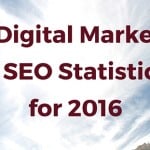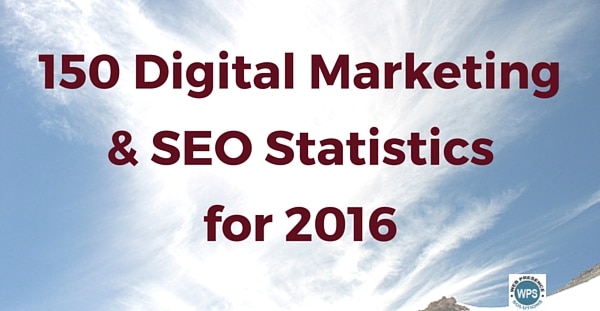Business planning and goal setting for digital marketing and SEO can be challenging in the rapidly changing online world. To assist in the process we have compiled a wide range of SEO statistics plus a wide range of content marketing, email marketing, social media, Internet growth and e-commerce statistics.
Each of the 150 statistics is followed by a link to the source for the given statistic. Each source will provide additional information and potentially some added context. Solid information will help turn dollars spent on SEO (think SEO ROI) and digital marketing into business success.
A goal with this post was to compile hard numbers and statistics, while avoiding opinions and conjectures, to help readers establish a clearer baseline for 2016.
Also be sure to check out some of the statistics we’ve collected for 2017: 25 SEO Statistics to Know in 2017 and 25 Email marketing Statistics to Know in 2017.
Where do these 150 SEO & Digital Marketing Statistics Come From?
The Internet abounds with statements on size, market share, growth rate, past and projected revenue, number of active users and much more. A pet peeve of mine is that all too frequently the statements and supposed facts I read online provide no source or attribution.
A common question after reading these standalone statements masquerading as facts is to ask “says who”? Or, “where do these numbers come from.” A goal of this post is to include answers to the “says who?” question and every statistic cited here lists a source.
Another consistent challenge I found in compiling these statistics is the age of the information. During my research for this post I came across a number of interesting statistics only to find that when I checked the sources the data was from three to six years old. Given the rapid rate of change in the online world citing an SEO statistic from 2011 or 2012 often provides limited value. The vast majority of the statistics in this post are from the last 12-15 months.
Given the large amount of data available on the web the statistics below represent only a narrow snapshot. If you have another useful stat or an excellent resource for more info please leave a comment. The stats below are divided in 6 sections. Some items could fit in multiple sections so I had to make some judgement calls. Enjoy.
SEO & Search Statistics
Takeaway: SEO delivers real value for businesses of all sizes; content marketing and SEO are 2 pieces of the digital marketing solution. (See more in the next section on Content Marketing statistics)

2. In the same Ascend2 report 48% of respondents identified keyword/phrase research as a most effective SEO tactic with 34% citing frequent website updates. (Source: MarketingProfs)
3. The average word count on pages in the top 10 search results has increased by around a quarter – rising from 975 in 2014 to 1,285 words in 2015. (Source: SearchMetrics)
4. A July 2015 study by Moz and BuzzSumo analyzed the shares and links of over 1 million articles and found that long form content of over 1,000 words consistently receives more shares and links than shorter form content (Source: Moz)
5. 86% of B2B marketers and 77% of B2C marketers use content marketing.
Search & SEO Statistics:
6. Google gets over 100 billion searches a month worldwide. (Source: Mashable)
7. As of May 2015 more Google searches take place on mobile devices than on computers in 10 countries including the US and Japan. (Source: Google)
8. In November 2015, Google’s Desktop market share was 64%, compared with 21% for Microsoft and 12.5% for Yahoo. (Source: Comscore)
9. Google had 94% of the worldwide mobile (smartphone and tablet) search market share in December 2015. (Source: NetMarketshare)
10. February 2015 polling by Econsultancy showed that 73% of in-house marketers and 76% of US agencies said SEO provided excellent or good return on investment (ROI). (Source: eMarketer)
11. June 2015 research of marketers by Ascend2 showed 89% worldwide rated SEO successful at achieving objectives of improved search rankings, website traffic and lead generation. (Source: eMarketer)
12. According to research from RBC Capital Markets conducted in September 2015, 64% of US small and medium-sized businesses had a professional website for their business, and an additional 10% planned to create one. (Source: eMarketer)
13. 25% of all websites globally use WordPress as their development platform as of November 2015 (Source: W3Techs)
14. Among the group of SMBs (small and medium size businesses) that had or planned to create a website, just 33% had a mobile-optimized site in September 2015. (Source: eMarketer)
15. Of the small businesses with websites 10% updated their site at least once a week, 33% at least once a month, and 21% once per year or longer. (Source: eMarketer)
16. In the May 2015 survey from BrightLocal 61% of consumers said that they are more likely to contact a local business if they have a mobile optimized site. (Source: BrightLocal)
17. 18% of local smartphone searches led to a purchase within a day compared to 7% on non-local searches.
18. 71% of B2B researchers start their research with a generic search.
19. The average human attention span in 2000 was 12 seconds, but by 2013 it was only 8 seconds. (Source: Microsoft)
20. The number of mobile-only Internet users now exceeds desktop-only users in the U.S. as of March 2015. (Source: Comscore)
21. 72% of consumers who did a local search visited a store within 5 miles. (Source: Wordstream)
22. 43% of consumers do online research while in the store. (Source: Wordstream)
23. 57% of customers say they won’t recommend a business with a poorly designed mobile site and 40 percent have turned to a competitor’s site after a bad experience.
24. 1 in 3 smartphone searches were made right before a store visit. (Source: Google)
25. 4 in 5 consumers conduct local searches on search engines – 88% on smartphones, 84% on computer/tablet.
26. 50% of consumers visit a store within a day of their local search on a smartphone.
27. 34% of consumers visit a store within a day of their local search on a computer or tablet.
28. 77% of mobile searches are made where a desktop PC is available.
29. 52% of mobile users consider the physical address to be the most important piece of information on a local business website and 47% said that map/driving directions are most important. 44% say opening hours are most important & 37% say a phone number according to May 2015 Survey by BrightLocal. (Source: BrightLocal)
30. 48% Identified keyword/phrase research as a most effective SEO tactic with 34% citing frequent website update. (Source: MarketingProfs)
31. Changing search algorithms (40%) and budget constraints (38%) are considered the most challenging obstacles to SEO success. (Source: Marketing Charts)
32. More than 7 in 10 respondents feel that their SEO effectiveness is improving either significantly (15%) or modestly (56%). (Source: Marketing Charts)
33. On average, B2B influencers do 12 searches prior to visiting a specific brand’s site.
34. Those involved in the B2B buying process are already 57% of the way down the path to a decision before they’ll actually perform an action on your site.
35. 90% of B2B researchers who are online use search specifically to research business purchases.
36. 49% of B2B researchers who use their mobile devices for product research do so while at work.
Content Marketing Statistics
Takeaway: Content marketing and SEO are 2 pieces of the same solution. Both are needed as part of a successful online strategy. As defined by the Content Marketing Institute, “Content marketing is a marketing technique of creating and distributing valuable, relevant and consistent content to attract and acquire a clearly defined audience – with the objective of driving profitable customer action.”

38. In the same study by Moz and BuzzSumo in a randomly selected sample of 100,000 posts over 50% had 2 or less Facebook interactions (shares, likes or comments) and over 75% had zero external links. This suggests there is a lot of very poor content out there and also that people are very poor at amplifying their content. (Source: Moz)
39. In a September 2015 study by the Content Marketing Institute (CMI) and MarketingProfs, 76% of B2B marketers in North America said they expect to create more content in 2016 than they did in 2015. (Source: eMarketer)
40. 45% of marketers say blogging is their #1 most important content strategy. (Source: Social Media Examiner)
41. 69% of marketers say they plan to increase their use of blogging this year. (Source: Social Media Examiner)
B2B Content Marketing Stats
42. 85% of B2B marketers say lead generation will be their most important content marketing goal in 2016. Sales will be their second priority. (Source: Content Marketing Institute)
43. 88% of B2B marketers currently use content marketing as part of their marketing strategy, yet only 32% have a documented content marketing strategy. (Source: Content Marketing Institute)
44. In a July 2015 Ascend2 study of B2B marketing professionals, 43% of respondents asserted that content marketing was one of the most effective tactics for lead generation. (Source: eMarketer).
45. 60% of B2B marketers report that their top challenge in 2016 will be producing engaging content. 57% say measuring content effectiveness will be their greatest challenge. (Source: Content Marketing Institute)
46. 88% of B2B companies report using content marketing, with 76% saying they will produce more content in 2016. (Source: Content Marketing Institute)
47. 60% of B2B companies say the biggest challenge in creating new assets is producing engaging content. (Source: Content Marketing Institute)
48. 85% of B2B companies say lead generation is the most important goal for content marketing, with 31% saying lead quality is the most important metric to study. (Source: Content Marketing Institute)
49. 76% of B2B marketers in North America said they expect to create more content in 2016 than they did in 2015 according to a September 2015 study by the Content Marketing Institute (CMI) and MarketingProfs. (Source: eMarketer).
B2C Content Marketing Stats
50. Compared to 2015, 77% of B2C marketers say they will produce more content in 2016. Only 2% will produce less. (Source: Content Marketing Institute)
51. The most effective content marketing strategy for B2C businesses is eNewsletters (61% of marketers say these are effective). Other effective strategies are in-person events (67%), illustrations/photos (66%) and social media content (66%). (Source: Content Marketing Institute)
52. The most popular social media platform among B2C businesses is Facebook, with 94% of respondents reporting its usage. Other popular platforms are Twitter (82%), YouTube (77%) and LinkedIn (76%). (Source: Content Marketing Institute)
53. 66% of B2C marketers say Facebook is their most effective social platform; this is followed by YouTube (53%), Twitter (50%) and Instagram (42%). (Source: Content Marketing Institute)
54. The #1 content marketing goal for B2C businesses in 2016 is sales (83%), followed by customer retention and loyalty (81%) and engagement (81%). (Source: Content Marketing Institute)
Email Marketing Statistics
Takeaway: Email marketing works and deliver strong ROI. “The Direct Marketing Association says email marketing returns $43 for every dollar invested in it. While that’s incredibly impressive, it’s even more impressive when you realize that figure averages in a lot of low-performing programs. There are some brands that are generating email marketing ROIs of $80, which they’re achieving with aggressive, smart spending on technology and services.”

55. Projected number of e-mail users in the U.S. by 2019: 251.7 million.
56. Gmail has over 900 million active users as of May 2015.
57. 75% of Gmail users open their email on a mobile device as of May 2015.
58. 51.7% of emails were opened on smartphones and 15% were opened on Tablets, with 33.3% opened on desktop/laptop computers according to Movable Ink’s US Consumer Device Preference Report for Q3 2015.
59. In the same Movable Ink report they found 41.4% of email opens occurred on an iPhone.
60. According to findings by The Relevancy Group in April 2015, US marketing executives believe that email marketing alone drives the same level of revenue as their social media, website and display ad efforts combined.
61. In the Email Marketing Industry Census 2015, eConsultancy & Adestra found that among digital marketers 79% ranked ROI from email “good” or “excellent”, 76% ranked ROI from SEO “good” or “excellent”, and 35% ranked ROI from social media as “good” or “excellent”.
62. The open rate for e-mails with a personalized message was 17.6%, as compared to 11.4% without any personalization.
63. Email marketing was the biggest marketing channel on Black Friday 2015, driving 25.1% of all transactions, according to Custora. Beyond email 21.1% of sales originated through organic search and 16.3% through paid search, while social media (including Facebook, Twitter, Instagram, and Pinterest) drove only 1.7% of sales.
64. 72% of consumers chose email when asked, “In which of the following ways, if any, would you prefer companies to communicate with you?” according to MarketingSherpa. Postal mail was a distant second with 48% of respondents.
65. A survey by Bizrate Insights found that 23% of potential online buyers purposely abandon their shopping carts in order to collect coupons that sellers send to try and close the sale.
66. Based on Q3 2015 data from SaleCycle, when retailers send email notifications about abandoned carts, the emails have a healthy 40.5% open rate.
67. Listrak reported that in Q2 2015 open rates for US shopping cart abandonment email campaigns averaged 28.0% among its clients with a 21.0% conversion rate.
68. Listrak also reported that Back-in-Stock emails had an average open rate of 51.9% with an average conversion rate of 25.3% for Q2 2015.
69. 86% of consumers said they would like to receive promotional e-mails from companies they do business with at least monthly, and 15% like to get them daily.
70. Separate research from Experian Marketing Services is in line with the Yesmail study. According to the Q2 2015 data, 48% of all emails sent by Experian clients were opened on desktop devices and 40% of emails were opened on mobile phones and ereaders. Some 12% were opened on tablets.
71. Mobile click-to-open rates for US marketing emails sent by Yesmail clients in Q3 2015 were at 13.7%, up 1.6% compared to Q3 2014. Desktop click-to-open rates for marketing emails in Q3 2015 were at 18.0%, down 3.8% from the year before.
72. Email marketing was rated effective by more agency marketers than any other channel with 79% of agencies stating that email provides excellent or good ROI, according to an Econsultancy study in February 2015.
73. Among client-side marketers, organic search was rated higher, but email was still the No. 2 channel, with 66% support.
74. A January 2015 survey by Demand Metric and the Direct Marketing Association (DMA) found higher ratings for email’s ROI than for any other channel or format studied.
Social Media Statistics
Takeaway: Social media continues to grow significantly and is used by all age groups. At the same time social media business ROI measurement remains challenging, especially for smaller businesses.

76. Nearly two-thirds of American adults (65%) use social networking sites, up from 7% when Pew Research Center began systematically tracking social media usage in 2005.
77. 35% of all those 65 and older report using social media, compared with just 2% in 2005.
78. Young adults (ages 18 to 29) are the most likely to use social media with 90% using one or more platforms.
79. 41% of US small businesses surveyed in Spring 2015 said they didn’t use social media for business. This was up slightly from 38% in Fall 2014 and even with the 41% in Spring 2014.
80. December 2014 research by Zogby Analytics found that 48.2% of US small-business owners didn’t use any social media for business purposes.
81. In a January 2015 study by Social Media Examiner, just over 4 in 10 small and medium-sized business (SMB) marketers worldwide said they were able to measure the ROI of their social media activities.
82. April 2015 polling by Manta found that nearly 6 in 10 US small-business owners (SBOs) still weren’t seeing ROI from social media activities.
83. In the April 2015 survey by Manta of small business owners the respondents were most likely to see a return of less than $100 per month from social media marketing. Just 13.5% generated monthly social media ROI of more than $1,000.
84. In Spring 2015 the top social media channels used by small businesses were Facebook (41%), LinkedIn (17%), Google+ (13%) and Twitter (12%) according to Ebiquity.
85. Thrive Analytics found in January 2015 that many SMBs (small and medium-sized businesses) just don’t have the resources to keep up with social media.
86. Fully 55% of small businesses updated social media business content monthly or less frequently, while just 15% did so daily and 30% weekly. This likely means the social followers theses small businesses have—who often demand real-time, or close to real-time, info—are seeing out-of-date content.
87. ROI: In the Email Marketing Industry Census 2015, eConsultancy & Adestra found that among digital marketers 79% ranked ROI from email “good” or “excellent”, 76% ranked ROI from SEO “good” or “excellent”, and 35% ranked ROI from social media as “good” or “excellent.”
88. Facebook and other social media sites ranked as the second most effective marketing method among US small and medium-sized businesses (SMBs) surveyed in January 2015.
89. Currently adoption rates for social media stand at 76% for those with college or graduate degrees, 70% of those with some college education and 54% for those who have a high school diploma or less.

91. Facebook had 167 million daily active users (DAUs) in the US and Canada as of Q3 2015, with 1.01 billion daily users worldwide.
92. Facebook has 217 monthly active users (MAUs) in the US and Canada with 1.55 billion monthly users worldwide as of Q3 2015.
93. 72% of adult Internet users are on Facebook as of August 2015.
94. Facebook continues to have the most engaged users. 70% log on daily, including 43% who do so several times a day as of August 2015.
95. Facebook reported 894 million Mobile Daily Active Users (DAUs) on average for September 2015, an increase of 27% year-over-year.
96. Within the overall Facebook family there are 900 million WhatsApp users, 700 million Facebook Messenger users, and over 400 million Instagram users as of Q3 2015.
97. There are 925+ million people using Facebook Groups as of Q3 2015
98. Twitter has 320 million monthly active users as of September 2015.
99. 80% of active users access Twitter via mobile devices as of September 2015.
100. 38% of those on Twitter use the site daily as of August 2015.
101. There were 400 million registered users on LinkedIn as of December 2015.
102. 25% of adult Internet users are on LinkedIn as of August 2015.
103. Pinterest has over 100 million monthly active users (MAUs) as of September 2015.
104. 31% of adult Internet users are on Pinterest as of August 2015.
105. Mobile ads now makes up a very significant 78% of Facebook’s advertising revenue, up from 76% in Q2.
106. In Q3 2015, 727 million of Facebook’s 1.55 billion Million active users were mobile-only, equivalent to 47% of users who have never interacted with Facebook on a desktop computer.
107. In Q3 2015, 78% of Facebook’s $4.3 billion in advertising revenue worldwide came from ads on mobile devices.
108. Instagram reports 400 million users with over 75% living outside the US as of September 2015.
109. 28% of US adult Internet users are on Instagram as of August 2015.
110. 55% of US Instagram users are ages 18-29 as of August 2015.
111. 59% of US Instagram users are on the platform daily, including 35% who visit several times a day as of August 2015.
112. As of September 2015, the greatest share of traffic to Instagram was from the United States with 23.9% percent of traffic, while traffic from the United Kingdom accounted for 3.57% of site visits.
113. In 2015, 40.7% of the U.S. smartphone users accessed Instagram.
Internet Statistics including Devices Usage
Takeaway: Internet usage continues to grow significantly with smartphone access and usage growing the fastest. Here are some smartphone usage and SEO statistics.

115. The share of American adults who own a smartphone, computer and a tablet has doubled since 2012 from 15% to 30%.
116. People now spend more time using apps than watching TV. In 2015, U.S. consumers spent 198 minutes in mobile apps per day compared to 168 minutes watching TV.
117. Half of all adult shoppers conduct product research on mobile devices while shopping in physical stores.
118. 66% of Americans own at least two digital devices – smartphone, desktop or laptop computer, or tablet – and 36% own all three.
119. 18% of American adults own only one of the three devices. Among single-device owners, 60% say they have a desktop or laptop computer, compared with a third (34%) whose only device is a smartphone, while 7% report their sole device as a tablet.
120. 16% of U.S. adults do not have a smartphone, desktop or laptop, or tablet.
121. There are 7.1 billion mobile subscribers globally as of November 2015.
122. More than 95% of the world’s population are now within reach of a mobile network signal.
123. For 2016, the number of smartphone users in the United States is estimated to reach 207.2 million, up from 190.5 million in 2015.
124. 50% of adults shop on smartphones while browsing a store.
125. 38% of mobile users search at least one time per month for a local business.
126. As of November 2015 Apple had a 43.1% share of Smartphone subscribers and Samsung had 28% of subscribers. LG was in third place with 9.6% of Smartphone subscribers.
127. There are now over 727 million mobile-only Facebook users.
Holiday Season 2015 eCommerce Statistics
Takeaway: E-Commerce Business was good and growing during the 2015 holiday season (November 1 – December 31). The holiday season statistics below are from Custora, a predictive marketing platform, that provides a free online dashboard tracking real-time online transactions.
128. The 2015 holiday shopping season (Nov. 1 – Dec. 31) was a strong one for US e-commerce retailers with revenue up 12.1% over the same period in 2014.
129. E-commerce revenue was up 16.2% on Cyber Monday 2015 compared to Cyber Monday 2014, making it the biggest day in US online shopping history.
130. For the full 2015 holiday weekend (Thanksgiving day through Cyber Monday), revenue growth over 2014 came in strong at 16.4%.
131. A total of 30.4% of online sales were placed on mobile (phones and tablets) during the 2015 holiday shopping season (Nov. 1 – Dec. 31), up from 25.9% of sales in 2014.
132. The share of transactions made on mobile phones during the 2015 holiday shopping season (Nov. 1 – Dec. 31) climbed from 14% in 2014 up to nearly 19.9%% in 2015.
133. Apple continued to rule the mobile shopping game with 76.9% of orders placed on iOS devices during the 2015 holiday shopping season.
134. Consumers using Android devices accounted for 22.7% of online transactions over the 2015 holiday shopping season, up slightly from 20.7% in 2014.
135. Search ruled holiday shopping in 2015, claiming a combined total of 39.2% of orders: organic (free) search with 21.5% and paid search with 17.7%.
136. E-mail marketing was the leading channel behind search, driving an impressive 20% of online sales during the 2015 holiday shopping season (Nov. 1 – Dec. 31).
137. Social media (Facebook, Twitter, and Pinterest, etc.) drove only 1.8% of sales during the 2015 holiday shopping season, down slightly from 1.9% of sales in 2014.
138. Cyber Monday e-commerce revenue was up 16.2% over Cyber Monday 2014, and orders (transactions) were up 14.7%.
139. Mobile Shopping (e-commerce orders made on mobile phones and tablets) accounted for 26.9% of orders on Cyber Monday 2015, a jump from only 23% on Cyber Monday 2014.
140. For the full holiday weekend, mobile shopping accounted for 32.1% of orders, up from 26.4% over the same period in 2014.
141. Black Friday was “Mobile Friday,” with mobile accounting for 36.1% of orders, up from 30.3% of orders on Black Friday 2014.
142. The vast majority of mobile shopping happened on Apple devices over the Black Friday-Cyber Monday weekend – 78.1%, while only 21.6% happened on Android devices.
143. Apple’s share is down from 79.6% on last year’s holiday weekend 2014, while Android’s share is up from 19.7%.
144. Email Marketing was the channel that drove the most online sales on Black Friday. While usually lagging behind online search (free and paid), on Black Friday 2015 email marketing was the primary channel, driving 25.1% of sales.
145. Beyond email, 21.1% of sales originated through free search, and 16.3% through paid search on Black Friday.
146. Cyber Monday exhibited a similar trend, though less pronounced – with email marketing driving 22.1% of orders, free search 20.7%, and paid search 16.6%.
147. For the holiday weekend, the story is similar, with email marketing generating 23.3% of orders, free search 20.5%, and paid search 15.9%.
148. Social media (including Facebook, Twitter, Instagram, and Pinterest) was not a meaningful channel during the holiday 2015 weekend, driving only 1.6% of e-commerce orders. The same applies to Cyber Monday, where social media networks drove 1.5% of orders.
149. The strong growth overall for the weekend was driven by mobile shopping (Apple devices in particular), email marketing, and Google search.
150. The share of orders placed on desktop computers over the 2015 holiday shopping season dropped from 74.2% in 2014 to 69% in 2015.
Conclusion:
Good information leads to better decisions. This posts contained a wide range of SEO statistics that can serve as starting points for shaping business SEO, content marketing, email marketing, social media marketing and website development strategies in 2016. The next step is to identify which numbers are most useful to your business and dig in. Following the Source links will provide additional information and further context for the numbers.
There are a huge number of other metrics and statistics beyond this list. If you have other useful statistics or related resources you’d like to share please leave a comment below. Thanks.
Hand Selected Related Posts (click title to read):
25 Email marketing Statistics to Know in 2017



